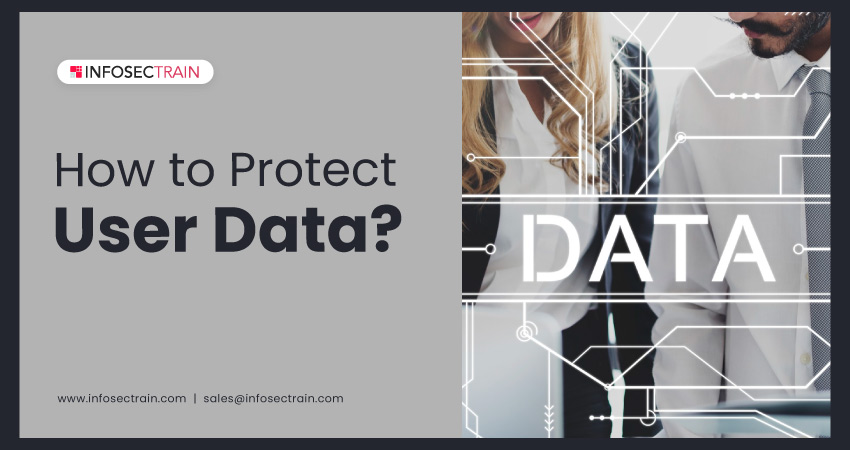How to Protect User Data?
Data is the most prized possession anybody has in this digital era, where practically every aspect of our lives can be digitized, tracked, and logged. Companies and governments collect, store, process, and trade enormous personal information nowadays. With this, the threat of data breaches is increasing every day. Cybercriminals are continuously evolving new and sophisticated avenues to gain access to databases that contain sensitive information that they can use for malicious purposes, such as selling it on the dark web.

Every day we come across news of data breaches that impact individuals and businesses. You may have heard or read about the Equifax data breach, one of the most significant security breaches of the 21st century. In September of 2017, Equifax experienced a data breach that exposed the extremely sensitive personal information of 147 million individuals (approximately 605 million records were compromised). Despite having security measures in place, the organization was compromised because it neglected to patch a fundamental vulnerability. This demonstrates how even a minor security gap can significantly impact the security of user data.
Data protection and privacy have therefore become two important and raging topics. Even more legislation, such as GDPR and CCPA, have been created, and many more are in the process of being created. Companies must take proactive measures to secure their users’ data in order to maintain customer trust, prevent reputation damage and legal repercussions, and avoid hefty fines. This article entails various steps or best practices you and your business or organization can follow to protect users’ data.
Essential data protection methods:
- Have strong password policies in place: If your business or organization has elaborate password policies, it would be difficult for cybercriminals to access your organizational IT infrastructure or network, and thus, it prevents data theft or breach. One of the simplest ways to protect user data is by encouraging them to use strong passwords. Passwords must be complex and difficult to guess, with a combination of letters, symbols, and numbers. Users should also be reminded not to use the same password across multiple accounts. Password managers such as LastPass and 1Password can be used to generate and store strong passwords. Users should also enable multi-factor authentication wherever possible.
- Minimize the data collection: One of the ways you can prevent user’s data is to limit the collection of data to only what is necessary for business activities. One of the effective ways to do so is to evaluate whether the data you are collecting is actually essential for the operation you are collecting it for; if not so, then do not collect unnecessary data. You can also audit your data collection by employing third-party security audits. This will eventually help decrease the external value of the data and decrease storage space and increase customer trust.
- Use data encryption whenever possible: Encryption is a process that transforms plaintext into ciphertext, which makes it unreadable without the proper decryption key. This method is useful in protecting user data such as credit card information, login credentials, and personal information. Encryption is widely used in secure communication, email, and online transactions.
- Minimize access to users: Every access is a vulnerability. Giving every employee or user unrestricted access may seem convenient, but it might leave your security exposed. Allowing all employees or users access to sensitive information increases the possibility of both insider threats and external hacking efforts. It is essential to adhere to the concept of least privilege to reduce these risks. This means that employees or users should only have access to the information and resources necessary for performing their job duties. By following this approach, you can reduce the likelihood of security breaches and protect the sensitive data of your business or organization.
- Implement robust tools: You must use robust technologies like firewalls to prevent data breaches. It is one of the most basic cyber protection tools that organizations of all sizes use to prevent data breaches.
- Monitor networks: Monitoring networks allows for early detection of potential security breaches, enabling quick responses to mitigate any damage to user data and prevent further unauthorized access.
- Monitor user activities: Monitoring user activities allows for the detection of unauthorized access or suspicious behavior, enabling prompt action to be taken to prevent data breaches and protect user data.
- Comply with data protection regulations: Complying with data protection regulations ensures that user data is handled lawfully, transparently, and securely, providing users with control over their personal information and reducing the risk of misuse or unauthorized access.
- Backup user data: Backing up user data is essential in case of a security breach or data loss. It is vital to have a backup plan in place to ensure that users’ data can be restored quickly in case of a data loss event. This method can also help prevent the loss of sensitive data.
- Use storage with built-in data protection: Using storage with built-in data protection ensures that user data is safeguarded from data corruption, loss, or unauthorized access, providing an added layer of security for their sensitive information.
- Perform third-party security audits: Performing third-party security audits can identify vulnerabilities in systems and processes that could compromise user data, allowing for timely mitigation of risks and enhancing overall data protection.
- Create a robust cybersecurity culture: When you create a strong cybersecurity culture in your organization, it promotes awareness, education, and best practices, leading to better protection of user data and mitigating risks of cyber attacks.
How can InfosecTrain help?
Protecting user data is crucial for maintaining user trust and avoiding costly legal repercussions. It is also important to understand that 100% security is a myth. However, you can follow various methods to protect user data effectively, and businesses must implement strong security measures such as encryption, regular data backups, and access controls. Additionally, it is essential to educate users on best practices for protecting their own data.
At InfosecTrain, we are dedicated to providing training that will help you and your user’s gain the utmost data protection and security. Our various data privacy and protection training courses, like GDPR, CDPP, CIPM, CIPT, CIPP/E, CDPO, and CDPSE, will provide you with knowledge and skills related to cybersecurity, including data protection techniques, threat identification and prevention, and best practices for the secure handling of user data.
TRAINING CALENDAR of Upcoming Batches For CIPP/E
| Start Date | End Date | Start - End Time | Batch Type | Training Mode | Batch Status | |
|---|---|---|---|---|---|---|
| 16-Nov-2024 | 01-Dec-2024 | 19:00 - 23:00 IST | Weekend | Online | [ Open ] | |
| 04-Jan-2025 | 19-Jan-2025 | 09:00 - 13:00 IST | Weekend | Online | [ Open ] | |
| 04-Jan-2025 | 19-Jan-2025 | 19:00 - 23:00 IST | Weekend | Online | [ Open ] |








 1800-843-7890 (India)
1800-843-7890 (India) 
